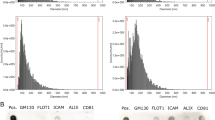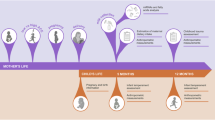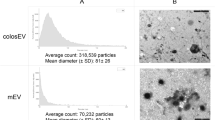Abstract
Background
Maternal breast milk (MBM) is enriched in microRNAs, factors that regulate protein translation throughout the human body. MBM from mothers of term and preterm infants differs in nutrient, hormone, and bioactive-factor composition, but the microRNA differences between these groups have not been compared. We hypothesized that gestational age at delivery influences microRNA in MBM, particularly microRNAs involved in immunologic and metabolic regulation.
Methods
MBM from mothers of premature infants (pMBM) obtained 3–4 weeks post delivery was compared with MBM from mothers of term infants obtained at birth (tColostrum) and 3–4 weeks post delivery (tMBM). The microRNA profile in lipid and skim fractions of each sample was evaluated with high-throughput sequencing.
Results
The expression profiles of nine microRNAs in lipid and skim pMBM differed from those in tMBM. Gene targets of these microRNAs were functionally related to elemental metabolism and lipid biosynthesis. The microRNA profile of tColostrum was also distinct from that of pMBM, but it clustered closely with tMBM. Twenty-one microRNAs correlated with gestational age demonstrated limited relationships with method of delivery, but not other maternal–infant factors.
Conclusion
Premature delivery results in a unique MBM microRNA profile with metabolic targets. This suggests that preterm milk may have adaptive functions for growth in premature infants.
Similar content being viewed by others
Log in or create a free account to read this content
Gain free access to this article, as well as selected content from this journal and more on nature.com
or
References
Anderson GH, Atkinson SA, Bryan MH . Energy and macronutrient content of human milk during early lactation from mothers giving birth prematurely and at term. Am J Clin Nutr 1981;34:258–65.
Lemons JA, Moye L, Hall D et al, Differences in the composition of preterm and term human milk during early lactation. Pediatr Res 1982;16:113–7.
Aquilio E, Spagnoli R, Seri S et al, Trace element content in human milk during lactation of preterm newborns. Biol Trace Elem Res 1996;51:63–70.
Schanler RJ, Lau C, Hurst NM et al, Randomized trial of donor human milk vs preterm formula as substitutes for mothers' own milk in the feeding of extremely premature infants. Pediatrics 2005;116:400–6.
Alsaweed M, Hartmann PE, Geddes DT et al, MicroRNAs in breastmilk and the lactating breast: potential immunoprotectors and developmental regulators for the infant and the mother. Int J Environ Res Public Health 2015;12:13981–14020.
Weber JA, Baxter DH, Zhang S et al, The microRNA spectrum in 12 body fluids. Clin Chem 2010;56:1733–41.
Muroya S, Hagi T, Kimura A et al, Lactogenic hormones alter cellular and extracellular microRNA expression in bovine mammary epithelial cell culture. J Anim Sci Biotechnol 2016;7:8–18.
Hassiotou F, Alsaweed M, Savigni D et al, Profiling of human milk miRNA. FASEB J 2015;29:582–8.
Alsaweed M, Lai CT, Hartmann PE et al, Human milk miRNAs primarily originate from the mammary gland resulting in unique miRNA profiles of fractionated milk. Sci Rep 2016;6:1–13.
Zhou Q, Li M, Wang X et al, Immune-related microRNAs are abundant in breast milk exosomes. Int J Biol Sci 2012;8:118–23.
Alsaweed M, Ching TL, Hartmann PE et al, Human milk cells contain numerous miRNAs that may change with milk removal and regulate multiple physiological processes. Int J Mol Sci 2016;17:956–86.
Rottiers V, Näär AM . MicroRNAs in metabolism and metabolic disorders. Nat Rev Mol Cell Biol 2012;13:239–50.
Munch EM, Harris RA, Mohammad M et al, Transcriptome profiling of microRNA by Next-Gen deep sequencing reveals known and novel miRNA species in the lipid fraction of human breast milk. PLoS ONE 2013;8:e50564.
Arntz OJ, Pieters BC, Oliveira MC et al, Oral administration of bovine milk derived extracellular vesicles attenuates arthritis in two mouse models. Mol Nutr Food Res 2015;59:1701–12.
Savage JS, Birch LL, Marini M et al, Effect of the INSIGHT responsive parenting intervention on rapid infant weight gain and overweight status at age 1 year: a randomized clinical trial. JAMA Pediatr 2016;170:742–9.
Vlachos IS, Zagganas K, Paraskevopoulou MD et al, DIANA-miRPath v3. 0: deciphering microRNA function with experimental support. Nucleic Acids Res 2015;43:W460–6.
Szklarczyk D, Franceschini A, Wyder S et al, STRING v10: protein–protein interaction networks, integrated over the tree of life. Nucleic Acids Res 2015;43:D447–52.
Walley AJ, Blakemore AI, Froguel P . Genetics of obesity and the prediction of risk for health. Hum Mol Genet 2006;15:R124–30.
Ikeda K, Horie-Inoue K, Ueno T et al, miR-378a-3p modulates tamoxifen sensitivity in breast cancer MCF-7 cells through targeting GOLT1A. Sci Rep 2015;5:1–12.
Gonul O, Aydin HH, Kalmis E et al, Effects of Ganoderma lucidum (higher basidiomycetes) extracts on the miRNA profile and telomerase activity of the MCF-7 breast cancer cell line. Int J Med Mushrooms 2015;17:231–9.
Qin W, Tang Y, Yang N et al, Potential role of circulating microRNAs as a biomarker for unexplained recurrent spontaneous abortion. Fertil and Steril 2016;105:1247–54.
Shah MY, Pan X, Fix LN et al, 5‐fluorouracil drug alters the microrna expression profiles in MCF‐7 breast cancer cells. J Cell Physiol 2011;226:1868–78.
Matamala N, Vargas MT, González-Cámpora R et al, MicroRNA deregulation in triple negative breast cancer reveals a role of miR-498 in regulating BRCA1 expression. Oncotarget 2016;7:20068–79.
Zhang K, Zhao S, Wang Q et al, Identification of micrornas in nipple discharge as potential diagnostic biomarkers for breast cancer. Ann Surg Oncol 2015;22:536–44.
Yang F, Zhang W, Shen Y et al, Identification of dysregulated microRNAs in triple-negative breast cancer. Int J Onc 2015;46:927–32.
Kumari A . Changes in MicroRNA target Sites Attributed to Single Nucleotide Polymorphisms may Influence Breast Cancer Susceptibility. Doctoral Dissertation, 2014.
Maltseva DV, Galatenko VV, Samatov TR et al, miRNome of inflammatory breast cancer. BMC Res Notes 2014;7:871–81.
Lingwood CA . Glycosphingolipid functions. Cold Spring Harb Persp Biol 2011;3:a004788.
van Meer G, Lisman Q . Sphingolipid transport: rafts and translocators. J Biol Chem 2002;277:25855–8.
Jiang M, Sang X, Hong Z . Beyond nutrients: food‐derived microRNAs provide cross‐kingdom regulation. Bioessays 2012;34:280–4.
Arroyo JD, Chevillet JR, Kroh EM et al, Argonaute2 complexes carry a population of circulating microRNAs independent of vesicles in human plasma. Proc Natl Acad Sci USA 2011;108:5003–8.
Hill PD, Aldag JC, Demirtas H et al, Association of serum prolactin and oxytocin with milk production in mothers of preterm and term infants. Biol Res Nurs 2009;10:340–9.
Ferraro L, Ravo M, Nassa G et al, Effects of oestrogen on microRNA expression in hormone-responsive breast cancer cells. Horm Cancer 2012;3:65–78.
Cochrane DR, Spoelstra NS, Richer JK . The role of miRNAs in progesterone action. Mol Cell Endocrinol 2012;357:50–9.
Sethi JK, Hotamisligil GS . The role of TNFα in adipocyte metabolism. Semin Cell Dev Biol 1999;10:19–29.
Wang L, Du Z, Liu J et al, Association of UCP3, APN, and TNF-α Gene polymorphisms with type 2 diabetes in a population of northern Chinese Han patients. Chem Res Chinese Univ 2012;28:255–8.
Nisoli E, Tonello C, Landi M et al, Functional studies of the first selective beta 3-adrenergic receptor antagonist SR 59230A in rat brown adipocytes. Mol Pharmacol 1996;49:7–14.
Lee MJ, Fried SK . The glucocorticoid receptor, not the mineralocorticoid receptor, plays the dominant role in adipogenesis and adipokine production in human adipocytes. Int J Obes 2014;38:1228–33.
Culpin RE, Proctor SJ, Angus B et al, A 9-series microRNA signature differentiates between germinal centre and activated B-cell-like diffuse large B-cell lymphoma cell lines. Int J Oncol 2010;37:367–77.
Golding J, Emmett PM, Rogers IS . Gastroenteritis, diarrhoea and breast feeding. Early Hum Dev 1997;49:S83–S103.
Acknowledgements
We thank Jessica Beiler for assistance in sample collection, Frank Middleton for guidance in RNA analysis, and Yuka Imamura for expertise in RNA sequencing.
Author information
Authors and Affiliations
Corresponding author
Ethics declarations
Competing interests
Hicks holds a preliminary patent for microRNA biomarkers in autism spectrum disorder and serves as a consultant for Motion Intelligence. Kelleher serves as the president and CEO of LactoGenix. These conflicts of interest are unrelated to the current manuscript and are under an active management plan by the Penn State College of Medicine.
Additional information
STATEMENT OF FINANCIAL SUPPORT
Funding provided by the Center for Research on Women and Newborn Health, The Gerber Foundation, the NIDDK (1R01DK099364-03), and the Departments of Surgery and Pediatrics at the Penn State College of Medicine.
Supplementary material is linked to the online version of the paper at
Supplementary information
Rights and permissions
About this article
Cite this article
Carney, M., Tarasiuk, A., DiAngelo, S. et al. Metabolism-related microRNAs in maternal breast milk are influenced by premature delivery. Pediatr Res 82, 226–236 (2017). https://doi.org/10.1038/pr.2017.54
Received:
Accepted:
Published:
Issue date:
DOI: https://doi.org/10.1038/pr.2017.54
This article is cited by
-
Regulation of adipogenesis by exosomal milk miRNA
Reviews in Endocrine and Metabolic Disorders (2023)
-
The relationship between microRNAs and bladder cancer: are microRNAs useful to predict bladder cancer in suspicious patients?
International Urology and Nephrology (2023)
-
Recent trends in miRNA therapeutics and the application of plant miRNA for prevention and treatment of human diseases
Future Journal of Pharmaceutical Sciences (2022)
-
Human milk extracellular vesicle miRNA expression and associations with maternal characteristics in a population-based cohort from the Faroe Islands
Scientific Reports (2021)
-
Unravelling the mysteries of microRNA in breast milk
Nature (2020)



